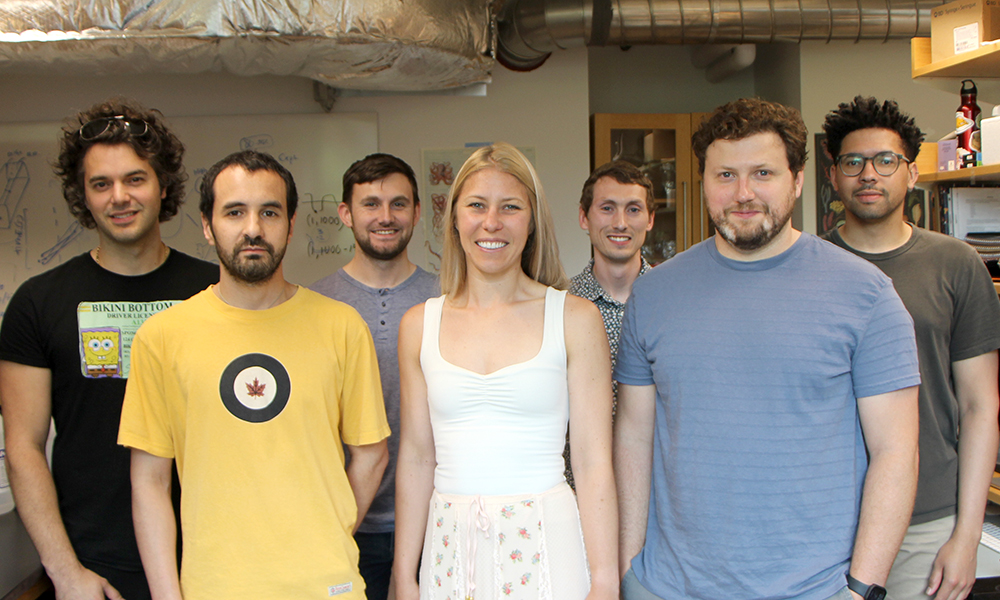Receiving a fellowship is a key milestone, as well as an important source of funding, for many postdocs. Many labs, such as the Bellono Lab, go out of their way to encourage postdocs to apply for fellowships. MCB faculty Nick Bellono sees the postdoc application process as a way for postdocs to clarify their ideas and hone their communication skills.
“When postdoctoral fellows join our group, we aim to establish a project and trajectory they can develop toward transitioning to being an independent scientist,” Bellono says. “This can include conceptual or experimental approaches and collaborations, but the major goal is to come up with an interesting biological question. I encourage them to think about: (1) something that is tractable from an interesting organismal behavior or trait to a reductionist molecular analysis (ideally one or a few proteins); (2) a question and topic they could explain to someone they pass on the street – something anyone can appreciate as a cool thing to do. That’s the privilege of being a scientist and I encourage them to take advantage of it! Putting all of this in context of a proposal helps shape the scope of the project with respect to the resources required, the most important experiments, and identifying useful collaborators. And, of course, an added bonus is to build their CV and get some funds.”
He adds, “Obviously, the primary reason postdoctoral fellows from our group receive fellowships is because they are super talented, hardworking, curious, and creative. I’m fortunate to work with them. My role is to provide guidance regarding interesting unanswered questions and scientific communication, which I believe is so important. Not only for writing papers, grants, presentations, teaching, but to help shape how we think about and approach science.”
This year, six postdocs from the Bellono Lab have been awarded fellowships: Corey Allard earned both a fellowship from the Charles A. King Trust and a seed grant from the Harvard Brain Science Initiative’s Postdoc Pioneers program. Maxwell Coyle received an NIH F32 grant. Loranzie Rogers won a Helen Hay Whitney Foundation research fellowship as well as a Postdoctoral Diversity Enrichment Program grant from the Burroughs Wellcome Fund. Trey Scott, who is a joint postdoc in the Bellono Lab and the Pierce Lab in OEB, was awarded a fellowship from the Jane Coffin Childs Memorial Fund for Medical Research. Rebecka Sepela won a grant from the Harvard Brain Science Initiative’s Postdoc Pioneer Program. Pablo Villar del Río also received a fellowship from the Jane Coffin Childs Memorial Fund.
To learn more about these postdocs and their research, read on!
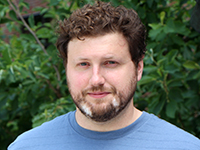
Corey Allard
Corey Allard is in his final year as a postdoc in the Bellono Lab, where he studies rarely investigated aquatic organisms such as sea slugs and mud-dwelling sea robins. He has received a fellowship from the Charles A. King Trust and a seed grant through Harvard Brain Science Initiative’s (HBI) Postdoc Pioneers grant program. The Charles A. King Trust supports Massachusetts-based postdocs in the mid to late stages of their postdoctoral positions, while the HBI Postdoc Pioneers program enables Harvard researchers to pursue research projects outside of their lab’s core area of focus.
“I’m deeply grateful for the support of both the Harvard Brain Initiative, which supports projects that will explore new directions for both the lab and science more broadly, and the Charles King Trust, for recognizing the importance of basic research in improving human health,” he says.
Allard is preparing to establish his own lab at Harvard Medical School next year, and these fellowships will allow him to branch out further into his research. “These fellowships will support my work exploring new and unusual biology, like understanding how unique animal behaviors and unusual organismal physiologies are established at the level of cells and molecules,” Allard explains. “Two specific projects that these fellowships will allow me to continue pursuing include understanding how ‘photosynthetic’ sea slugs are able to steal chloroplasts from plants and incorporate them into their own cells, and exploring how novel sensory organs evolve and develop using sea robins – fish with unusual leg-like appendages used for finding prey concealed in sand.”
He adds, “These are curiosity-driven projects that are motivated by the incredible yet poorly understood biology of these weird and wonderful organisms. My goal is to extract fundamental principles from these studies that will apply broadly across organisms and deepen our understanding of how biological systems function and evolve.”
Allard is looking forward to establishing his own lab. “Next year, I will start my own lab at Harvard Medical School in the Department of Cell Biology, where I will continue to do curiosity-driven science exploring the physiology and behavior of unique and weird organisms, with the goal of broadening our understanding of how biology works,” he says.
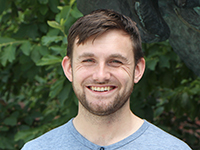
Maxwell Coyle
Maxwell Coyle aims to piece together how the earliest animal ancestors sensed and responded to their environments. “The NIH F32 grant supports my research into the deep ancestry of animal nervous systems,” he says. “Animals evolved from unicellular organisms, yet we know very little about how these organisms were able to process and communicate environmental information. To help reconstruct the role of sensory evolution in the unicellular to multicellular transition, I am studying sensation and behavior in a group of organisms called choanoflagellates, which are the closest living relatives of the animal group.”
“I was always taught to distinguish the biology of complicated multicellular organisms like plants and animals from the ‘simple’ biology of unicellular life,” he adds. “Our field is finding that unicellular organisms are not so simple after all, and we have an opportunity to investigate the fundamental molecular and cellular mechanisms that enable such a dramatic evolutionary transition like the one that led to the emergence of animal life.”
Also known as Ruth L. Kirschstein Postdoctoral Individual National Research Service Awards, F32s support the research of promising postdocs who plan to eventually start their own labs. F32s provide up to three years of funding to recipients. “I feel honored to have received this fellowship from the NIH,” Coyle says. “I hope that the fruits of my research justify the investment that they have made in my work.”
Coyle is relatively new to the Bellono Lab but is enjoying the atmosphere and collegiality. “My first few months in the Bellono Lab have been very exciting,” he says. “I’m learning new skills and am surrounded by so many talented and curious scientists.”
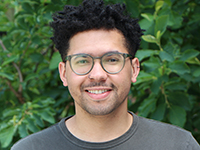
Loranzie Rogers
Loranzie Rogers is studying how amphibians’ sensory systems adapt during the metamorphosis from an aquatic tadpole to a land-dwelling adult. “We will mainly be focusing on how the olfactory system remodels during metamorphosis to allow for sensation across these diverse habitats,” he says.
The Helen Hay Whitney Foundation is providing a three-year research fellowship to Rogers, which will support his ongoing experiments. “I am both thrilled and thankful to have received support for this project, which will extend my training in new and exciting directions,” Rogers says. “Additionally, I am happy to be conducting this research in the Bellono lab, which encourages folks to explore new and interesting areas of biology.”
Rogers also received a grant from the Burroughs Wellcome Fund’s Postdoctoral Diversity Enrichment Program (PDEP), which supports postdoctoral scholars from underrepresented backgrounds. The PDEP award starts on September 1st and continues through August 2027.
Rogers adds, “I have always been really stoked by cool organisms and their unique adaptations, and this fellowship will allow me to continue to broadly explore organismal adaptations!”
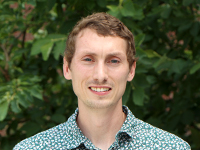
Trey Scott
Trey Scott is looking into a family of caterpillars that secrete special chemicals, allowing the caterpillars to recruit ants as their bodyguards. He is jointly advised by Bellono and OEB faculty Naomi Pierce.
Scott has received a postdoctoral fellowship from the Jane Coffin Childs Memorial Fund for Medical Research (JCC Fund). “I am mostly shocked to have gotten it,” Scott says. “I submitted this fellowship days after returning from Australia (where I was collecting caterpillars and ants) so I was jet lagged and out of it. Part of me thought I would not get everything done on time. Luckily, I did most of the work preparing the fellowship before I left Australia and everything turned out fine.”
In the Pierce and Bellono Labs, Scott is studying a family of butterflies and caterpillars that have developed a symbiotic relationship with ants. Normally, ants prey on slow-moving caterpillars, but these caterpillars have a special organ that secretes nutritious ooze to feed the ants. “My JCC fellowship will support my efforts to identify the chemicals that these caterpillars secrete along with the cellular and molecular features of the secretory organs that underlie this interaction between ants and caterpillars,” Scott says. “My motivation is mostly an obsession with these caterpillars. Any other caterpillar would be quickly gobbled up by ants, but these caterpillars are able to avoid being eaten and even to manipulate ants into protecting the caterpillars from predators. Because this ant interaction is so unique among caterpillars, there is much new biology to be learned by studying them.”
Scott adds that he is enjoying the collegiality and the diversity of research in the Bellono Lab. “I am having a great time in the Bellono Lab,” he says. “The amount of interdisciplinary work that is done in the lab is exciting. People work on a range of interesting organisms (from caterpillars and beetles to octopuses and axolotls) and ask a range of exciting questions (from figuring out how protein structure affects function to how chemosensory traits evolve). I feel like I am always learning something new.”
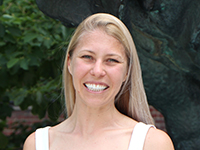
Rebecka Sepela
Rebecka Sepela is investigating forms of communication between animals and bacteria. “Animals diverged from their protistan ancestors three billion years after bacterial life originated and have been evolving within and adapting to this bacterial world ever since,” she explains. “I suspect that animals have developed an acute awareness of this invisible bacterial world, co-opting microbial chemical cues to navigate their surroundings and inform behaviors. For my project, I seek to uncover these interkingdom communiques to better understand the nature of the molecular pressures bacteria exert upon their animalian cohabitants. By interrogating how environmental pressures shape sensory system evolution, I ultimately hope to better understand how rapidly changing environments influence animal behavior and adaptation.”
“I am especially excited to think about interkingdom interactions as invisible forces that are susceptible to anthropogenic influences,” she adds. “Through the study of these interkingdom interactions, I hope to better understand how environmental pressures have shaped and continue to shape evolution on both long and short timescales and, further, to characterize the molecular underpinnings of animalian adaptation and resilience. I find this topic especially pressing considering our rapidly changing environment.”
In her project, Sepela will be leveraging the expertise of both the Bellono Lab, which studies unusual sensory systems in animals, and the Clardy Lab at HMS, which specializes in discovering biologically active natural compounds, which are often secreted by or used by bacteria.
The Harvard Brain Science Initiative (HBI) issued a Postdoc Pioneers grant to Sepela. These grants support postdoctoral research that is outside of their home lab’s area of focus. “I am very grateful to have received this grant as it brings together many exciting ideas and approaches from different Harvard labs and provides me with a great opportunity to chart an independent research path from which I can build my career,” she says. “Beyond that, this award grants me the privilege of sharing this research directive with junior scientists and I find that encouraging curiosity, independent thought, and training the next generation of scientists to be the most rewarding part of science.” She adds, “I would like to extend a special thank you to Nick for his scientific support. His ability to find beauty and intrigue in hidden places is a constant inspiration.”
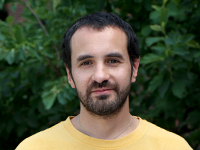
Pablo Villar del Río
Pablo Villar del Río’s postdoctoral research focuses on understanding the molecular underpinnings of octopus behavior. He is particularly interested in how octopuses sense their environment and transform this environmental data into precise behavioral responses.
He adds that he is motivated by “the curiosity to know what the sensory world of other animals looks like.”
These studies are supported by the Jane Coffin Childs Memorial Fund for Medical Research (JCC Fund). Since 1937, the JCC Fund has supported research into human disease and in more recent years, its mission has broadened to include basic research projects, like Scott’s and Villar del Río’s.
“I am very thankful to the Jane Coffin Childs fund for supporting my research and to Nick for sharing his passion for biology,” Villar del Río says.


